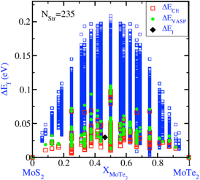Summary
Using methods such as electronic structure (such as density functional theory, tight-binding, quantum Monte Carlo), force-field, machine-learning and quantum computation, this project aims at increasing our knowledge of electronic and functional materials, to optimize their applicability in devices.
Description
Accelerating Materials Discovery using Machine Learning and AI
Using machine learning and AI techniques along with high-throughput DFT calculations materials with specific properties are identified to accelerate the the discovery process for a variety of applications. Some of the specific materials include charge density wave, IR, piezoelectric, and magnetic materials.
Density Functional Theory and Monte-Carlo (MC) Simulations to Identify Key Structure-Property Relations

Developing new quantum materials and devices requires a better understanding of structure-property relations. In collaboration with NIST experimentalists, DFT/MC (Monte-Carlo) simulations are used to clarify: topological states in semimetals; and the dynamics of magnetic skyrmions in monolayer materials with applied magnetic and/or electric fields. First Principles Phase Diagram simulations provide insights into phase stabilities and transformation behavior of 2D transition metal dichalcogenide (TMD) alloys. Insights from DFT/MC-simulations enable NIST-experimentalists to improve sample syntheses, and experimental methodologies.
JARVIS platform

JARVIS (Joint Automated Repository for Various Integrated Simulations) is a repository designed to automate materials discovery using classical force-field, density functional theory, machine learning calculations and experiments.
The Force-field section of JARVIS (JARVIS-FF) consists of thousands of automated LAMMPS based force-field calculations on DFT geometries. Some of the properties included in JARVIS-FF are energetics, elastic constants, surface energies, defect formations energies and phonon frequencies of materials.
The Density functional theory section of JARVIS (JARVIS-DFT) consists of thousands of VASP based calculations for 3D-bulk, single layer (2D), nanowire (1D) and molecular (0D) systems. Most of the calculations are carried out with optB88vDW functional. JARVIS-DFT includes materials data such as: energetics, diffraction pattern, radial distribution function, band-structure, density of states, carrier effective mass, temperature and carrier concentration dependent thermoelectric properties, elastic constants and gamma-point phonons.
The Machine-learning section of JARVIS (JARVIS-ML) consists of machine learning prediction tools, trained on JARVIS-DFT data. Some of the ML-predictions focus on energetics, heat of formation, GGA/METAGGA bandgaps, bulk and shear modulus.
- The Atomistic Line Graph Neural Network section of JARVIS(JARVIS-ALIGNN) uses graph neural network for fast property predictions, force-field and inverse design. There are about 100 pre-trained ALIGNN models available for various applications.
- The AtomVision section of JARVIS (JARVIS-AtomVision) is a deep learning framework for atomistic image data.
- The natural language processing section of JARVIS (JARVIS-ChemNLP) can be used for curating datasets and applying various machine learning models for text.
Workshops
- Artificial Intelligence in Materials Workshop
- 2025 Workshop
- 2024 Workshop
- 2023 Workshop: July 25-27, 2023
- 2022 Workshop recordings
- Quantum Matters in Materials Science
- 2025 Workshop
- 2024 Workshop
- 2023 Workshop Jan 31-Feb 1, 2023
- 2020 Workshop

